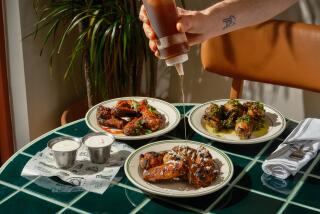Americans Eating More Ethnic Foods : Baby Boom Generation Leading Revolution in Food Tastes
WASHINGTON — Italian sausage and flan aren’t threatening frankfurters and apple pie as yet, but Americans seem to be increasingly willing to experiment in their diets.
Members of the post-World War II baby boom generation are leading the revolution in food tastes. Contributing to the nation’s changing diet are the trend toward smaller households and an increase in the median age, both of which tend to lead to increased use of restaurants and prepared foods.
“We think that the ethnic market is one of the hottest things going today,” said James H. Moran, spokesman for Campbell Soup Co. of Camden, N.J.
The rapid growth in the nation’s Latino population in recent years has led to an increase in Mexican and other restaurants of Spanish extraction, serving the fast-growing minority groups and exposing the rest of the population to a wider range of food.
Vietnamese Restaurants
Meanwhile, the end of the war in Southeast Asia led to a sudden influx of Vietnamese and other Asians--and a blossoming of restaurants and food stores serving their needs.
And while the Census Bureau reports that minorities make up a slightly larger proportion of the population than in 1970, Americans at large also are reaching out to new cultures and foods.
“There are a number of dynamics at work. People are becoming more venturesome in their outlook toward food, more willing to try new flavors, new food, new dishes,” observed Mark Gutsche, a spokesman for the Del Monte Co. in San Francisco, which produces Mexican and Chinese foods.
Americans, in general, have more money for discretionary spending, Gutsche said, and “more women are working, which leaves less time to spend in the kitchen. These products are quickly available in restaurants and easy to prepare at home.”
“We’ve become more sophisticated about food, more affluent, and can afford interesting kinds of foods. . . . People figure they both work hard, both men and women, and they want their eating experience to be something interesting,” said Moran.
Even Mexican restaurants in the United States aren’t what they used to be, adds Thomas C. Brenker, executive director of the Washington-based Mexican Food and Beverage Board. “The hottest thing about Mexican food today is the demand for a wider variety of authentic Mexican recipes” beyond the traditional American taste for tacos and enchiladas, he said.
Gutsche said some ethnic foods, particularly Asian foods, also “have an image as healthful, light, good for you. And these are definitely trends.”
“Once people have acquired the ethnic taste at a restaurant, they want to try to make it for themselves at home. . . . Supermarkets are finding it profitable to carry whole sections of ethnic items,” the trade magazine Food Engineering reported.
A National Restaurant Assn. consumer survey conducted in 1983 found that Italian restaurants were the most popular ethnic eateries for Americans, with 94% of those responding having eaten in such a restaurant at least once.
Chinese fare was second at 89% and Mexican food collected a hefty 88% to finish third. About 65% said they had eaten at a German restaurant, 59% had chosen French food, 56% Greek and 50% Japanese.
Other food nationalities that had been sampled by at least 10% of respondents included Spanish, British, East European, Scandinavian, Indian, Latin American, Middle Eastern and Russian.
More to Read
Eat your way across L.A.
Get our weekly Tasting Notes newsletter for reviews, news and more.
You may occasionally receive promotional content from the Los Angeles Times.








